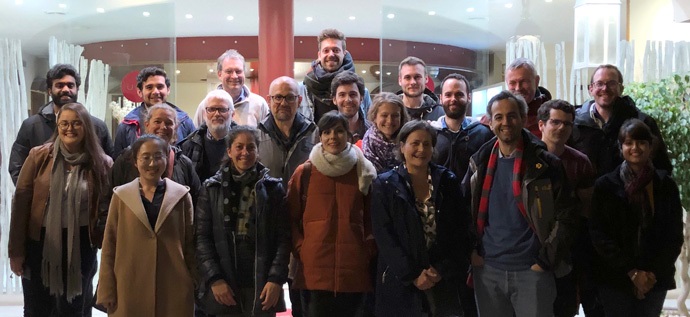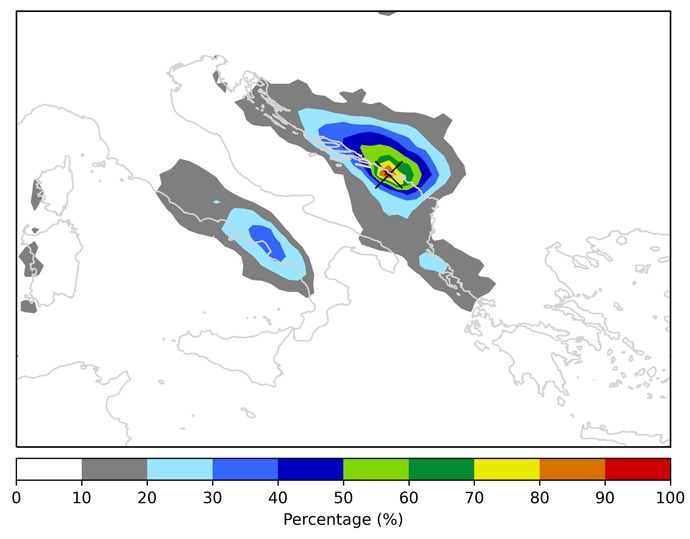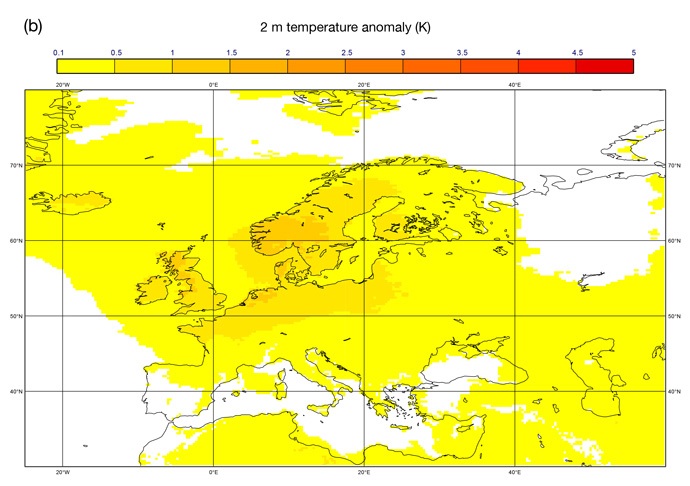 |
 |
Emmanuel Rouges and Nikolaos Mastrantonas, ECMWF Scientists, Diagnostics Team, Evaluation Section.
We are scientists in the ECMWF Diagnostics team working on the sub-seasonal predictability of extreme weather over Europe, within the EU-funded CAFE project. CAFE’s goal is to improve predictability at sub-seasonal timescales by developing an interdisciplinary network of highly trained researchers. There are 12 researchers in total, of which ECMWF hosts 2.
Our research at ECMWF is focused on sub-seasonal predictability over Europe and we share some of our early results in this blog, as well as discussing the importance of forecasting at this timescale.

Figure 1: The 12 early stage researchers (ESRs) and some of the senior researchers of the CAFE project, during the CAFE 1st summer school in Sitges, Spain, in November 2019.
Bridging the gap between medium and long-range forecasting
Weather and climate extremes can have serious impacts on our society, ranging from the destruction of crops and infrastructure, to fatalities. Mitigating these impacts is a key element of weather forecasting. While decisions based on short and medium-range forecasts can support such actions, utilising information derived from the sub-seasonal to seasonal range (S2S) can further extend the lead time, and provide the opportunity to implement additional (low-cost) measures well in advance (e.g. Ready-Set-Go! approach by Red Cross Climate Centre).
This S2S (or extended) time range sits between medium-range day-to-day weather forecasting and the seasonal range and beyond (or long range).
Medium-range forecasting is mainly an initial condition problem, while predictability at the long (seasonal) range is strongly dependent on the slow internal variability of the climate system e.g. varying sea surface temperatures.
For a long time, the S2S range was considered a “predictability desert”. However more recently, potential sources of predictability have been discovered.
Sub-seasonal forecasting and ECMWF
Recognising the importance of sub-seasonal forecasts, there is an ongoing effort by many research centres and organisations for advancing this field; an effort spurred on by the WMO.
ECMWF, even though focusing on medium-range forecasting, is actively involved in this effort providing a variety of products extending even beyond seasonal scales. In fact, some of the targets of the centre for the coming years include the S2S predictability of high impact weather up to two weeks ahead, as well as the predictions of large-scale patterns and regime transitions up to four weeks ahead. The S2S range is moreover a core component of the seamless prediction approach, that is central to ECMWF’s strategy.
In this broader context of S2S research activities within ECMWF, the Centre invests in the extended-range predictability of weather extremes over two areas of immense importance for our users and Member and Co-operating States: Europe and the Mediterranean.
Nikolaos’s project: Predictability of large-scale atmospheric flow patterns over the Mediterranean connected to extreme weather
The Mediterranean is often affected by extreme weather events (e.g. torrential rainfall, cyclones, and droughts). Climate change is already altering the risks from such events. My research aims to analyse the predictability of the large-scale drivers (e.g. high/low pressure systems) of such hazards, and thus, contribute to mitigating the related risks.
The work is split into 3 sections. Initially I will assess the spatio-temporal characteristics of extreme events in the Mediterranean and quantify the links between local extremes and large-scale patterns. Then the work will investigate the predictability of the previously identified large-scale patterns in current numerical weather prediction (NWP) models. The final part is related to teleconnections, and the identification of distant drivers in space/time, that can further enhance the predictability of large-scale patterns over the Mediterranean.
Currently, my focus is on linking extreme precipitation events (EPEs) to large-scale patterns. There are some initial results in my poster presented at EGU2020. The findings indicate that the large-scale atmospheric variability in the low- and mid-troposphere has a clear connection with EPEs over the domain. The importance of orography is also very interesting (Figure 2). More than 30% of EPEs (defined based on 99th percentile) over parts of west Italy occur on the same day as EPEs over the coast of Croatia and Montenegro, a connection that emerges due to the Apennine Ranges.
My project is supervised by Linus Magnusson, ECMWF, and co-supervised by Prof. Matschullat, TU Bergakademie Freiberg, Germany

Figure 2: Percentage of EPEs over the locations within the selected domain (Italy, Balkans), that occur on the same day as EPEs over the coast of Croatia and Montenegro (black cross). The EPEs are defined based on the 99th percentile of daily precipitation data.
Emmanuel’s project: Extreme weather situations and cascade effects based on European climate patterns
Heatwaves have already impacted our society greatly; as a prime example the summer of 2003 caused upwards of 70,000 fatalities (Stefanon et al. 2012). In a warming climate, the consequences are potentially more dramatic. This increases the urgency for accurate prediction, especially on longer timescales, to mitigate their impact.
My project will follow three main steps. The foundation is understanding the drivers of heatwaves. The next step will be to evaluate the capability of the ECMWF forecasting model to represent heatwaves and their drivers. The newly gained understanding will lead to the development of a heatwave early warning system.
During the first year, we used empirical orthogonal functions to pre-filter data, and hierarchical clustering to identify the main large-scale patterns related to heatwave events (preliminary results are shown in my poster at EGU2020). The first results show that each type of heatwave is characterised by a typical large-scale circulation pattern. The main and common feature is an anti-cyclone centred over the heatwave region which persists during the heatwave (Figure 3). Further results highlight that typical atmospheric patterns can be identified as triggers. Together with sources of predictability identified by the community (e.g. the Madden-Julian Oscillation) we will be able to understand how to better predict heatwaves at the S2S timescale
My project is supervised by Laura Ferranti, ECMWF, and co-supervised by Prof. Kantz, TU Dresden, Germany.


Figure 3: Geopotential anomaly at 500 hPa (a) and 2 m temperature anomaly compared to 90th percentile (b) for one large-scale circulation pattern related to heatwaves over Europe.
More about the CAFE project
CAFE is an EU Marie-Curie funded Innovative Training Network. The project consortium is formed by twenty international partners across Europe and Uruguay recruiting, hosting and training researchers. These partners cover a range of disciplines and sectors. There are forecasts centres (ECMWF, Meteo-France), private companies (e.g. ARIA), and research institutes/universities (e.g. CRM, MPI), while the areas of expertise cover climate and atmospheric sciences, complex systems, mathematics, physics, etc.
12 early stage researchers (ESRs) form the core of the project, and their research aims to improve sub-seasonal predictability of extreme weather events using disciplines ranging from climate science to complex networks.
As well as the two of us, ECMWF will host two more ESRs for a two to four month scientific exchange: (Xinjia Hu co-supervised by Laura Ferranti and Shraddha Gupta co-supervised by Director of Forecasts Florian Pappenberger).
Laura Ferranti, Linus Magnusson and Florian Pappenberger will also teach in workshops and seminars organised by the project, with one of them scheduled to be hosted at ECMWF.
